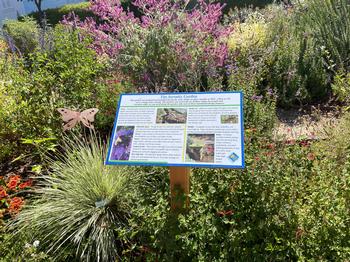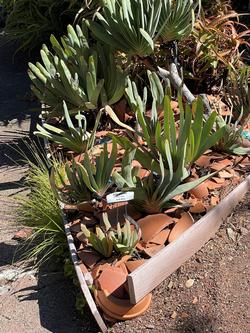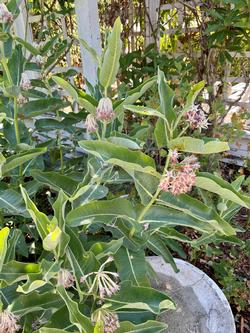Explore the UC Marin Master Gardeners’ Demonstration Gardens
-
Jane Scurich
-
As the reality of our water crisis settles in and we begin to think seriously about saving every precious drop, it’s time to plan for some drought tolerant replacements for our lawns as well as thirsty annuals and perennials. Garden books and visits to local nurseries provide lots of ideas, but there is nothing like observing a drought tolerant specimen thriving in an actual garden. There’s no place better to begin your search than the UC Marin Master Gardener demonstration gardens.
 The Serenity Garden gives outdoor refuge for people & creatures, with defensible space, sound, scent, a place to rest & a dry creek bed. Jane Scurich
The Serenity Garden gives outdoor refuge for people & creatures, with defensible space, sound, scent, a place to rest & a dry creek bed. Jane ScurichFor a scenic, educational stroll, visit Harvey’s Garden at Blackie’s Pasture in Tiburon. Started in 1995, this sun-drenched, deer resistant, pesticide free public garden features some 2500 plants providing year-round color to a former summer dust bowl. Markers indicate the botanical and common name with educational notes. The half-acre garden is maintained by UC Marin Master Gardeners with assistance from local volunteers. On work days, they are happy to answer questions and offer suggestions for your home garden.
A visit to the demonstration gardens at Falkirk Cultural Center on Mission Avenue in San Rafael will provide you with some great examples of plants that grow well in Marin and have low water needs. Six themed gardens will fill you with inspiration of the beauty you can achieve while lowering your water use:
 Creative design integrates recycled materials in the Succulent Garden at Falkirk. Photo: Jane Scurich
Creative design integrates recycled materials in the Succulent Garden at Falkirk. Photo: Jane Scurich- The Xeriscape Garden has no irrigation and features plants that succeed with absolutely nothing but seasonal rainwater.
- The Mediterranean Climate Garden showcases plants that thrive in regions of the world with dry summers and temperate wet winters, like Marin.
- The dramatic Succulent Garden will enthrall lovers of these stunning low water use plants. The garden is designed with a bit of whimsy to inspire your creativity. Both full sun and partial shade species demonstrate the wide variety of plants available to transform your water demanding landscape to one that thrives with less moisture.
- The Habitat Gardens feature five diverse habitats: Under Oaks, California Natives, Beneficial Habitat, and California Diversity Gardens feature solutions to address a number of challenges you may have at your home.
- Learn about some fire safe garden concepts as you stroll through the Serenity Garden, filled with the hum and buzz of happy birds and bees savoring the nectar of beneficials.
- Imagine your own backyard filled with plants featured in the Moon Garden. Your nights will be transformed when these white and gray-white beauties “glow” in the evening. Plan a full moon visit to Falkirk to experience this magical garden!
The Falkirk gardens incorporate water saving concepts such as berms and swales to slow water flow and allow for percolation into the soil. Various forms of irrigation as well as ample use of mulches demonstrate strategies to decrease the need for supplemental water. Asclepias specious “showy milkweed” thrives in the Habitat Garden. This species is a larval host for Monarch butterflies. Photo: Jane Scurich
Asclepias specious “showy milkweed” thrives in the Habitat Garden. This species is a larval host for Monarch butterflies. Photo: Jane ScurichTo learn about growing your own food, the Edible Demo Garden at Indian Valley Organic Farm and Garden in Novato is a hands-on teaching tool for UC Marin Master Gardeners and the public.
The Edible Demo Gardens are designed to exhibit numerous methods of growing vegetables and fruit in different types of soil and with limited gardening space. Various sizes of raised beds, horse troughs, straw bales, and in-ground rows demonstrate ways to incorporate edibles in your garden space.
Everything in the 2100 sq.ft. Edible Demo Gardens is on drip irrigation with a solar powered controller. The drip lines are only activated on days when volunteers are not present as the preferred method is hand-watering to maintain precise control over each bed and conserve water. While the garden has been in constant cultivation during COVID, with limited volunteer accessibility, the organic produce from the garden has been donated to Homeward Bound to help feed our most vulnerable populations. COVID protocols currently limit accessibility to the IVC gardens.
For up-to-date information on workshops, volunteering, and farm stand produce at the Edible Demo Gardens refer to http://marinmg.ucanr.edu/LEARN/EDGNOVATO/. To schedule a private tour, email EdibleDemoGarden@MarinMG.org.
Late September into October is an ideal time to plant. Study the local demonstration gardens for ways to enhance your home with plants that work in our local climate.



